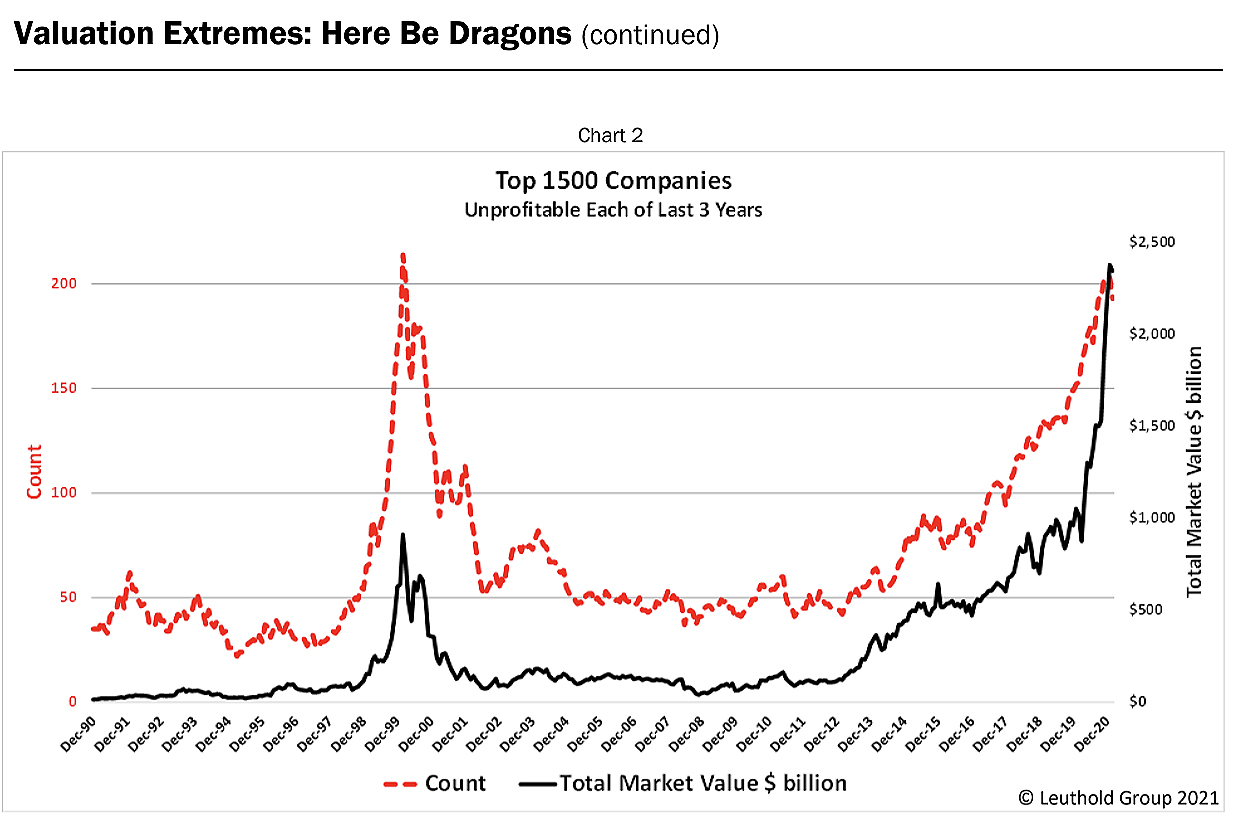
Latest Sign of a Stock Market Bubble:Company Profits No Longer Matter
How much is Wall Street willing to pay for a potentially good idea that hasn’t actually made any money yet? A lot, apparently.
Investors are pouring money into unprofitable companies more than any time since the dot-com bubble, according to a recent report by Scott Opsal, director of research at The Leuthold Group.
Of the largest 1,500 companies by market capitalization today, around 200 weren’t profitable during any of the last three years. But instead of punishing them, investors have rewarded them with a total market value of more than $2.3 trillion. Wall Street hasn’t been willing to attach such high market values to unprofitable companies since the late 1990s (and even then, the total market valuation of the unprofitable companies wasn’t even half of what it is now). Of course, if you’re betting on a company becoming profitable in the future, you’re taking a risk.
“You’re going off to these uncharted regions where just about anything might happen,” Opsal says.

So what are these companies that investors are so eager to throw their money at? Primarily, it’s those that have an established business in an area investors are hoping will go gangbusters, but haven’t quite taken off yet, Opsal says.
His examples include the plant-based meat company Beyond Meat, used cars e-commerce platform Carvana and streaming platform Roku. (Beyond Meat and Carvana did not respond to Money’s request for comment; a Roku representative pointed Money to an excerpt of its fourth-quarter 2020 letter to shareholders, which included that the company will continue to invest in the business to seed future growth.)
Are investors too bullish?
Normally, investors may be happy to rely on good-quality, low-volatility stocks that can pay some dividends.
But things aren’t normal right now. Bitcoin — the cryptocurrency which pays no dividends or interest — is soaring and a non-fungible tokens mania has people forking over thousands of dollars for digital art of Lebron James dunking and an animated cat with a Pop-Tart for a body. An army of everyday traders on Reddit recently sent “meme stocks” skyrocketing and Tesla’s stock seems unstoppable, all while the Dow and S&P 500 continue to hit record highs.
Whether or not this means we’re going to see a stock market bubble is up for debate, but the fact that unprofitable companies have such a big market value shows that market sentiment is high, Opsal says. For a lot of investors, making 8% to 10% a year on their investments may not cut it anymore. They’re looking for home runs.
“You only get those out of startups and innovators that might end up being the one champion winner out of the whole pack,” Opsal says.

Flashback to the dot-com bubble
Investors haven’t shown this much confidence in unprofitable companies in nearly 20 years. So what is similar between now and then?
A changing world. In the late 1990s, that change was thanks to the Internet. We went from 8% of households in the country having a computer in 1984 to 51% in 2000 as Dell and Apple duked it out for customers. The World Wide Web connected people across the world and, 20 years later, you’re probably shopping online just as much as you are in the store, if not more.
The world is once again changing…and fast. We’re on the cusp of a green revolution, and continue to see innovation in cloud computing and even space tourism, Opsal says. If any of these changes become as routine as hitting “buy” with an Amazon Prime account, some of the stocks betting on these changes will become real winners.

What’s the risk?
To build a forecast of an established and profitable company — think Nike or Starbucks — analysts can look at numbers like profit margins and historical growth rate. But a not-yet profitable company?
“We could almost pick any number out of the air and defend it as well as any other,” Opsal says.
One metric these companies tout is free cash flow, a way to measure cash that moves into and out of a companies coffers each quarter. Management knows that as long as they can generate cash flow, they can stay in business long enough to realize their vision, Opsal adds. But if they run out, it could be game over.
While the claim that medieval mapmakers labeled unchartered territories with the phrase “Here Be Dragons” may be unfounded, it’s ripe for an analogy here.
“If you’re willing to sail into the land of vision stocks and pay a big price for them, you might fall off the earth,” Opsal says. “You might get eaten by dragons.”
© 2021 LeackStat.com
